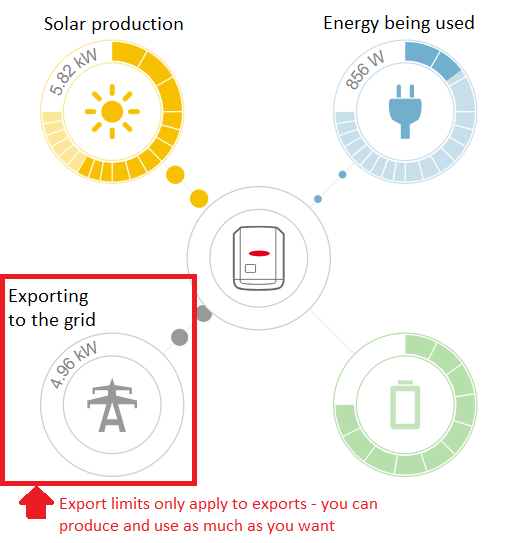Solar export limits – why they exist and how they work
Solar export limits – why they exist and how they work
Export limits refer to the cap or restriction on the amount of solar energy that can be exported back to the grid from your solar system. These limits are set by the network service providers (often called “the grid operators”) to manage the flow of electricity within the network, ensuring grid stability and safety.
The good news is – these export limits only apply after you have consumed the electricity you’re generating, in other words it’s an export limit on the excess production your solar makes, not your entire production. This means why it is important to use as much of your own solar production as you can.
For example, if your system was producing 8kW and your home was using 4kW you would only have 4kw left over to export. If you have an export limit of 5kW, you would have no issue and would be under the limit.
Why Do Export Limits Exist?
- Grid Stability: With the increased adoption of solar energy systems, the electricity grid can become inundated with excess energy, particularly during peak sunlight hours. To prevent potential overloads or instability, export limits are set.
- Safety Concerns: Overloading the grid can lead to voltage issues or even infrastructure damage. By placing limits, the grid operators can ensure a safer energy environment for everyone connected to the network.
- Ensuring Fair Distribution: On networks with a high number of solar installations, export limits can help ensure that everyone has an opportunity to feed energy back to the grid, promoting equitable distribution.
What are the export limits in Australia?
Export limits can vary based on the network service provider within a particular state or region, and they may also change over time as network conditions and regulations evolve.
In general each state limits work like this:
- Queensland (QLD): In Queensland, the export limits are often set by Energex and Ergon, the major distribution networks. Historically, the limits were set around 5kW for single-phase connections and 15kW for three-phase connections in many parts of the state. However, these limits can vary depending on the specific area and network conditions.
- New South Wales (NSW): Export limits in NSW can vary widely based on the distribution network. Endeavour Energy, Essential Energy, and Ausgrid are the major distributors. Depending on the distributor and local network conditions, limits have historically ranged from 5kW to 30kW, but this is a general range and the specific limit can differ.
- Victoria (VIC): In Victoria, distributors like Powercor, AusNet Services, and Jemena set the export limits. Similar to other states, the limits can range based on the region and the specific distributor, but historically they have been in the range of 5kW for single-phase connections and up to 30kW for three-phase connections.
It’s essential for homeowners and businesses to check with their local network service provider or distributor for the most up-to-date and accurate information regarding export limits in their specific area.
How Does This Impact Homeowners and Businesses?
Export limits on solar systems can have practical implications for both homeowners and businesses. If your system consistently generates more power than the set export limit, you won’t be able to feed all the excess energy back to the grid, potentially missing out on valuable feed-in tariffs. Moreover, if you have low electricity usage and your system is near the export cap, your peak energy production is effectively limited
For instance, if your household consumes 1kWh and the export limit is 5kWh, your system will cap its output at 6kWh—even if it has the capacity and sunlight to generate 10kWh. If you increase your home’s energy usage to 4kWh, with the 5kWh export limit, your system could produce up to 9kWh.

What Can You Do About It?
- Ensure Your System Sizing is Right According to the Limit: Before installation, work with your solar provider to design a system that aligns with the export limits of your region. This doesn’t necessarily mean installing a smaller system; instead, it means ensuring you make the most out of the energy you generate.
- Ensure Your Panel Placement Spreads the Time of Your Peak Power: Proper panel placement can influence the time of day when your system generates peak power. By distributing panels in various orientations (e.g., east-facing and west-facing), you can spread out the times of peak generation, ensuring a more consistent energy production throughout the day.
- Install A Solar Diverter: Solar diverters can redirect excess energy to specific appliances or systems within your home, such as water heaters. This means that instead of sending the surplus energy back to the grid (and potentially exceeding export limits), you can use it for immediate domestic needs.
- Install A Solar Battery: Installing a solar battery can be a game-changer. Batteries store excess energy generated by your solar panels. This stored energy can be used during times when the sun isn’t shining, like during the evening or on cloudy days, ensuring that you make the most of your solar energy without overloading the grid.
Conclusion
Navigating the intricacies of export limits can seem daunting, but with the right strategies and technologies, homeowners and businesses can effectively leverage their solar systems. By optimising system size, panel placement, and investing in tools like solar diverters and batteries, you can ensure that you make the most out of your solar investment. Remember, solar energy isn’t just about contributing to the grid; it’s about creating a sustainable, efficient energy solution for your home or business. With proper planning and the right support, you can enjoy the myriad benefits of solar energy in harmony with the broader energy network.
